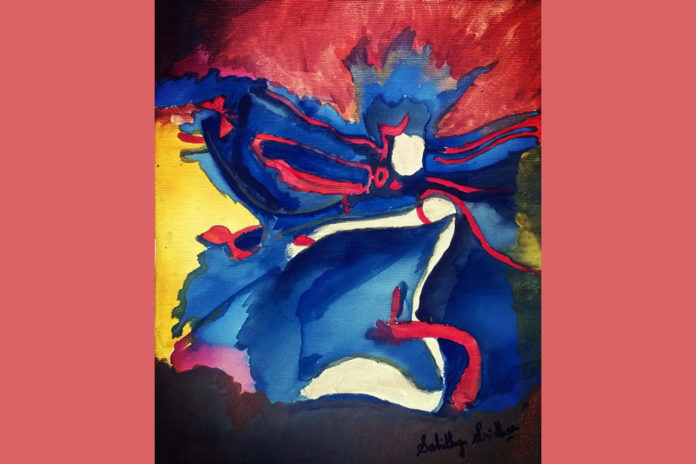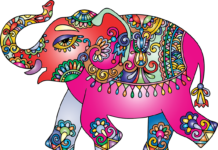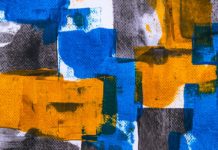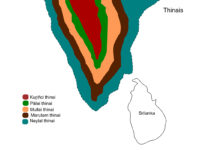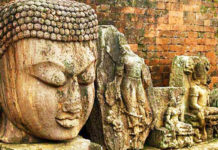English Translation by Dr. T.N. Ramachandran
1.
Has He placed on His crown
of matted hair the moon
against which billows
of the great Ganga dash?
Does He desire
the musical recitation
of the Sama Veda?
Does He hold a skull?
Is He the true One of golden hue
concorporate with Her
whose soft fingers sport a ball?
Is the supreme Yogi seated on a Bull?
Is He cinctured with a five-headed serpent?
If it be so, He is,for sure,
Atikai Virattan.
2.
Mounted on a Bull, does He
roam about the seven worlds?
Is He hailed and adored by the celestials?
Does He hold an alms-bowl of skull
on which is perched an eagle?
Does He sport in His broad chest
a hooded serpent?
Does He resemble a lovely coral hill
with stripes of Holy Ash?
Does He have an eye in His forehead?
Has He placed the crescent
on His crest where a river flows?
If it be so, He is, for sure,
Atikai Virattan.
3.
Does He wear on His dazzling body
a garland of skulls?
Is He the Beginning, the Middle and the End?
Is His neck adorned
with a kaarai of albescent tusk?
Does He dance, adorned with an angry adder?
Is He the activiser of the body`s elements?
Becoming vast earth, water,fire and ether,
does He abide
within and beyond the macrocosm?
If it be so,He is,for sure,
Atikai Virattan.
4.
Is He ruddy in hue?
Is His throat dark?
Adorned with a white-fanged snake
does He dance?
Is He the fierce One who quells Karma?
Is His matted hair
decked with cool and plaited konrais?
Does His hand hold mazhu and soolam?
Is He the threefold Time?
Is He the great One
Who, with fire, gutted the ankleted Kaama
that wielded the peerless bow of sweetcane?
Is His mount the huge and corpulent Bull?
If it be so, He is, for sure,
Atikai Virattan.
5.
Does He ceaselessly sing the four Vedas?
Does He wear on His spreading matted hair
a bright and moist and white moon?
Is His bright waist
girt with (tiger-)skin and snake?
Does red-lipped Uma
form part of His person?
Does He enact the great dance
to the playing of kudamuzhavam.
vina and cymbals
by the little Bhootas
that walk in small steps?
If it be so, He is, for sure,
Atikai Virattan.
6.
Does He destroy the ingrained malady
and also the killer-adversaries
of those that think on Him?
Does He, with the look of His one eye,
burn Kaama to powdery ash?
Does He draw onto His hirsutorufous,
matted crest, the torrent of Ganga?
Does He become the septet of worlds?
Does He, with a single dart,
annihilate the three mobile citadels?
Is He the One poised in the great Primal Tapas?
If it be so, He is, for sure,
Atikai Virattan.
7.
Does He dance to the singing,
to the piping of flute,
to the blaring of kokkarai,
to the clanging of cymbals
and to the beating of montai
by the small Bhootas?
Does He make movements of dance
with comely toes
above which He wears anklets,
and thus reveals His form in the dream?
Does He dance flexing
His beauteous shoulders?
Does He dance during each midnight
in the funeral pyre of the crematory?
Is He Ashtamoorti?
If it be so, He is, for sure,
Atikai Virattan.
8.
Is He the One who destroyed
the ichor-abounding and haughty tusker,
And who, with His hand stinking of tough flesh,
Covered his person, from head to foot,
with its hide, so as to become invisible?
Has He a throat darkened by His devouring
the venom of the noisy ocean
whose billows wailed aloud
when in great hubbub,
it was churned with a mountain
around which a snake was wound?
If it be so, He is, for sure,
Atikai Virattan.
9.
Does the great One`s ruddy, matted hair look
as if it were wrought of crimson gold
suffused with sheer beauty?
Is He the lovely Bridegroom of Uma
the fragrance of whose hair is divinely natural,
and whose coiffure is adorned
with sweet smelling and fresh flowers?
Does His right hand hold a mazhu?
Is He the One supremely desirable?
Is He the One hailed by the four Vedas?
Is He the One whose dart caused the quaking
and the destruction of the fearless, triple citadels?
Is He the One immanent
in all the worlds of the cosmos?
If it be so, He is, for sure,
Atikai Virattan.
10.
Is His abundant matted hair–
bright with the tender light of the moon–,
made moist with the spume
of the river`s rising waves?
Is there in His person comely scars
caused by the battling breasts of Kaamakotti
whose lips are like coral, and ruddy fruit?
Is there in His streaked chest the white thread?
Is He the Wearer of the white ash?
Is His body -perfect and divine–,
coated deep with aromatic unguent
and paste of sandalwood?
If it be so, He is, for sure,
Atikai Virattan.
11.
Is He the One who grew and grew
beyond the ken of the Tall one
and the Four-Faced, who,
in vain, pursued His base and top?
Is He the One beyond compare?
Does He that is entwined by a liana,
have a great and comely neck,
dark like a blue gem?
Is He clothed in the skin of a killer-tiger?
Is He the Wearer of a Kovanam?
Does ash cover His body?
Does He roam about the earth seeking alms?
Is He the Wearer of strands of thread?
Does He confer on His servitors
suzerainty over the immortals’ world?
If it be so, He is, for sure,
Atikai Virattan.
About the translator:
Dr.T.N. Ramachandran is a great scholar in both Tamil and English; an acknowledged authority on Tamil Saivism and Saiva Siddhanta; a prolific writer on several facets of Tamil hagiographical literature; a versatile translator of Tamil Saivite Scriptures; has published, translated and edited more than 100 books. More about him and his works at: http://drtnr.org/
About Tirumurai ( also spelt as Thirumurai ) :
Thirumurai (Tamil: திருமுறை, meaning holy division) is a twelve volume compendium of songs or hymns in praise of Lord Shiva in the Tamil language, written during 6th – 11th century AD by various poets. Nambi Andar Nambi compiled the first seven volumes composed by Appar, Sampandhar and Sundarar as Tevaram during the 12th century.
The above poems, are extracted from the Tirumurai of Appar (aka Tirunavukkarasar); he was born in the middle of the 7th century in Tiruvamur, Tamil Nadu, and had a childhood name of Marulneekiar. His sister, Thilagavathiar was betrothed to a military commander who died in action. When his sister was about to end her life, he pleaded with her not to leave him alone in the world. She decided to lead an aesthetic life and bring up her only brother. During boyhood, Appar was very much interested in Jainism and started studying its scriptures. He went away from home and stayed in their monastery and was renamed Darmasena. Details of Appar’s life are found in his own hymns and in Sekkizhar’s Periya Puranam (the last book of the 12 volume Tirumurai series). Appar had travelled to nearby Patalipura to join a Jain monastery where he was given the name Dharmasena. “Seeing the transient, ephemeral world he decided to probe into truth through renunciation.” After a while, afflicted by a painful illness, Dharmasena returned home. He prayed for relief at the Siva temple where his sister served and was cured. He was also involved in converting the Pallava king, Mahendravarman to Saivism. This was also the period of resurrection of the smaller Shiva temples. Appar sanctified all these temples by his verses and was also involved in cleaning of the dilapidated temples called uzhavarapadai. He was called Tirunavukkarasar, meaning the “King of divine speech”. He extolled Siva in 49,000 stanzas out of which 3130 are now available and compiled in Tirumurais 4-7. He is believed to have died at the age of 81 in Tirupugalur.



